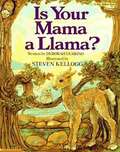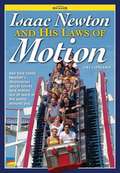- Table View
- List View
More NIMAC books are available at www.nimac.us. If you find your title in the NIMAC and not in Bookshare then please contact us to request it.
Is Your Mama A Llama?
by Deborah Guarino Steven KelloggWith the clever rhyming text of this book, readers will learn to identify many animals as they follow a baby llama in search of its mother. Text copyright 2004 Lectorum Publications, Inc.
Isaac Newton and his laws of Motion
by Mona ChiangLearn about Sir Isaac Newton's laws of motion and how the math behind them led scientists to make great discoveries that changed the world.
iScience [Grade 6] Oklahoma
by American Museum of Natural History Michelle Anderson Juli BerwaldNIMAC-sourced textbook
iScience [Grade 7]
by American Museum of Natural History Michelle Anderson Juli BerwaldNIMAC-sourced textbook
iScience [Grade 8]
by American Museum of Natural History Michelle Anderson Juli BerwaldNIMAC-sourced textbook
Ish: Make Your Mark... Move! (Into Reading, Read Aloud Module 5 #3)
by Peter ReynoldsNIMAC-sourced textbook
La isla de la doctora Chu desaparece (¡Arriba la Lectura!, Level V #70)
by Marianne Posadas Mat TaitLa millonaria Dra. Chu ha creado un paraíso artificial, pero los problemas están a punto de empezar. Cuando la isla empieza a derrumbarse bajo los efectos de un ciclón tropical, ella intenta desesperadamente averiguar qué se le olvidó: ¡algo que todo paraíso necesita! NIMAC-sourced textbook
Issues and Earth Science: Geological Processes, Revised
by Lawrence Hall of Science University of California BerkeleyNIMAC-sourced textbook <p>Where should we store our nuclear waste? Students learn about both gradual and sudden changes to the Earth’s surface, what causes them, and how they are monitored. They also explore how different kinds of rocks are formed and learn about some natural resources, where we find them, and how we use them. PE Assessment Example: Would you select one of the four suggested sites for storing nuclear waste? Explain. Use evidence from this unit to support your decision and identify any trade-offs. Geological Processes is part of Issues and Science three year middle school program, designed by SEPUP at the Lawrence Hall of Science. This six to seven week unit anchors the lessons around the the socio-science issue: Where should we store our nuclear waste? Investigative phenomena within the 18 activities connect back to the issue and storyline. This unit builds towards and assesses PEs ESS2-1, ESS2-2, ESS2-3, ESS3-1, ESS3-2. The Student Book guides students in exploring a socio-science issue and connected phemonena through a series of varied activity types. Activity types use one of twelve different instructional strategies to apply Science and Engineering Practices to specific Disciplinary Core Ideas and Cross Cutting Concepts. SEPUP's integrated literacy strategies help students process new science content, develop their analytical skills, make connections between related concepts, and express their knowledge orally and in writing. The built-in assessment system helps teachers identify students' strengths and weaknesses from the beginning of the unit. This allows them to adjust activities when needed so that all students get the best chance to build their knowledge and appreciation of science. At the back of the Student Book there is an Appendix containing additional resources for students, such as science skills, literacy strategies, and media literacy among others.</p>
Issues and Earth Science: Weather and Climate
by University of California at Berkeley Lawrence Hall of ScienceNIMAC-sourced textbook
Issues and Earth Science: Solar System and Beyond
by University of California at Berkeley Lawrence Hall of ScienceNIMAC-sourced textbook
Issues and Earth Science: Solar System and Beyond, Revised
by University of California at Berkeley Lawrence Hall of ScienceNIMAC-sourced textbook <p>What kinds of future space missions should we fund and conduct? Students take observations from their everyday life and build scientific models to try to understand how phenomena, such as changes in the moon’s appearance, seasons, and gravity work. Through data collection and analyzation students later use their understanding of what can be learned through space missions to determine the trade-offs of different proposed space missions. PE Assessment Example: Prepare a labeled diagram that includes a caption explaining how Earth’s tilt and its orbit around the Sun cause each of the following: a. changes in the angle of sunlight hitting the Earth’s surface. b. the seasons in the Southern Hemisphere to be opposite of the seasons in the Northern Hemisphere. Solar System and Beyond is part of Issues and Science three year middle school program, designed by SEPUP at the Lawrence Hall of Science. This five week unit anchors the lessons around the the socio-science issue: What kind of future space missions should we fund and conduct? Investigative phenomena within the 17 activities connect back to the issue and storyline. This unit builds towards and assesses PEs ESS1-1, ESS1-2, ESS1-3. The Student Book guides students in exploring a socio-science issue and connected phemonena through a series of varied activity types. Activity types use one of twelve different instructional strategies to apply Science and Engineering Practices to specific Disciplinary Core Ideas and Cross Cutting Concepts. SEPUP's integrated literacy strategies help students process new science content, develop their analytical skills, make connections between related concepts, and express their knowledge orally and in writing. The built-in assessment system helps teachers identify students' strengths and weaknesses from the beginning of the unit. This allows them to adjust activities when needed so that all students get the best chance to build their knowledge and appreciation of science. At the back of the Student Book there is an Appendix containing additional resources for students, such as science skills, literacy strategies, and media literacy among others.</p>


